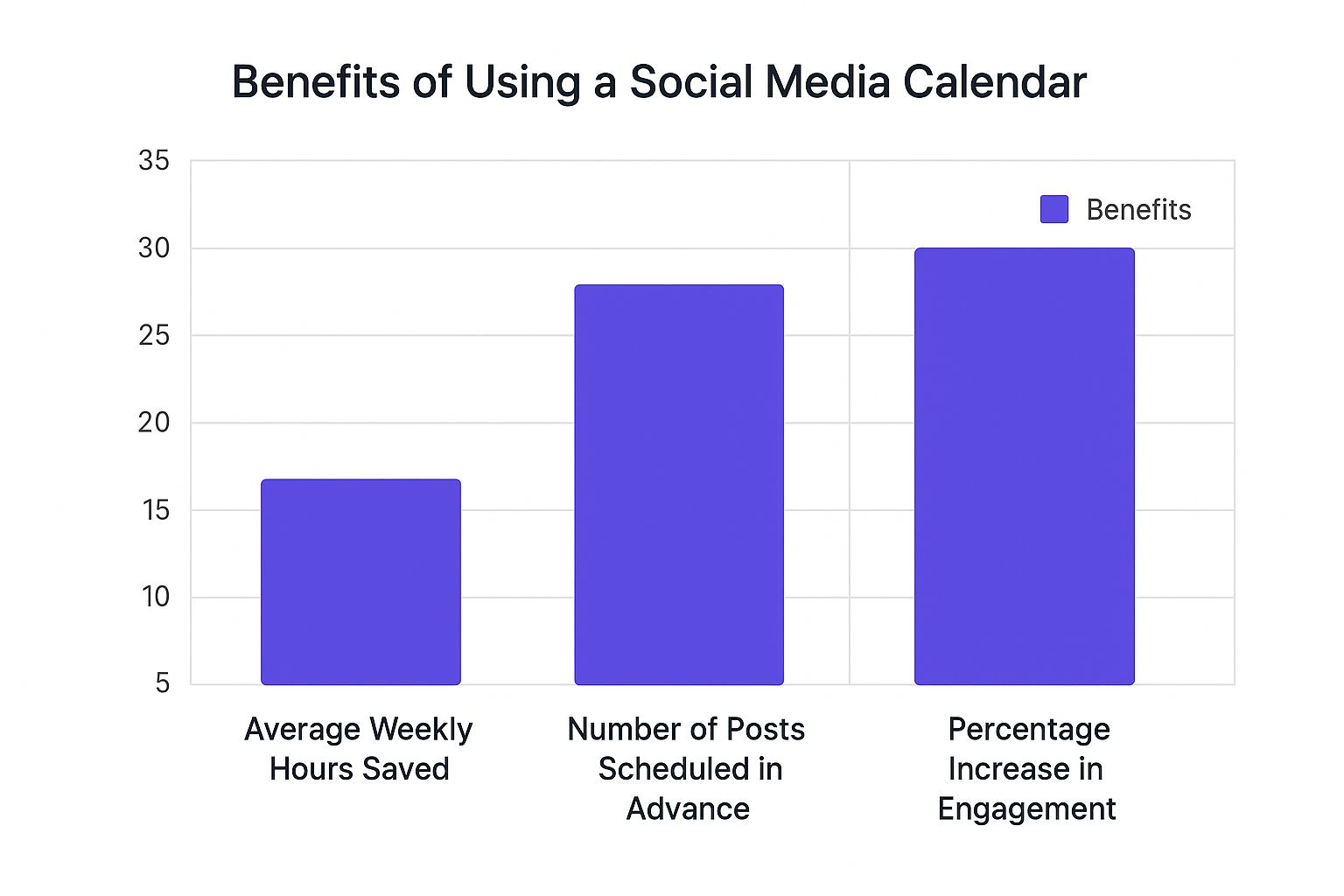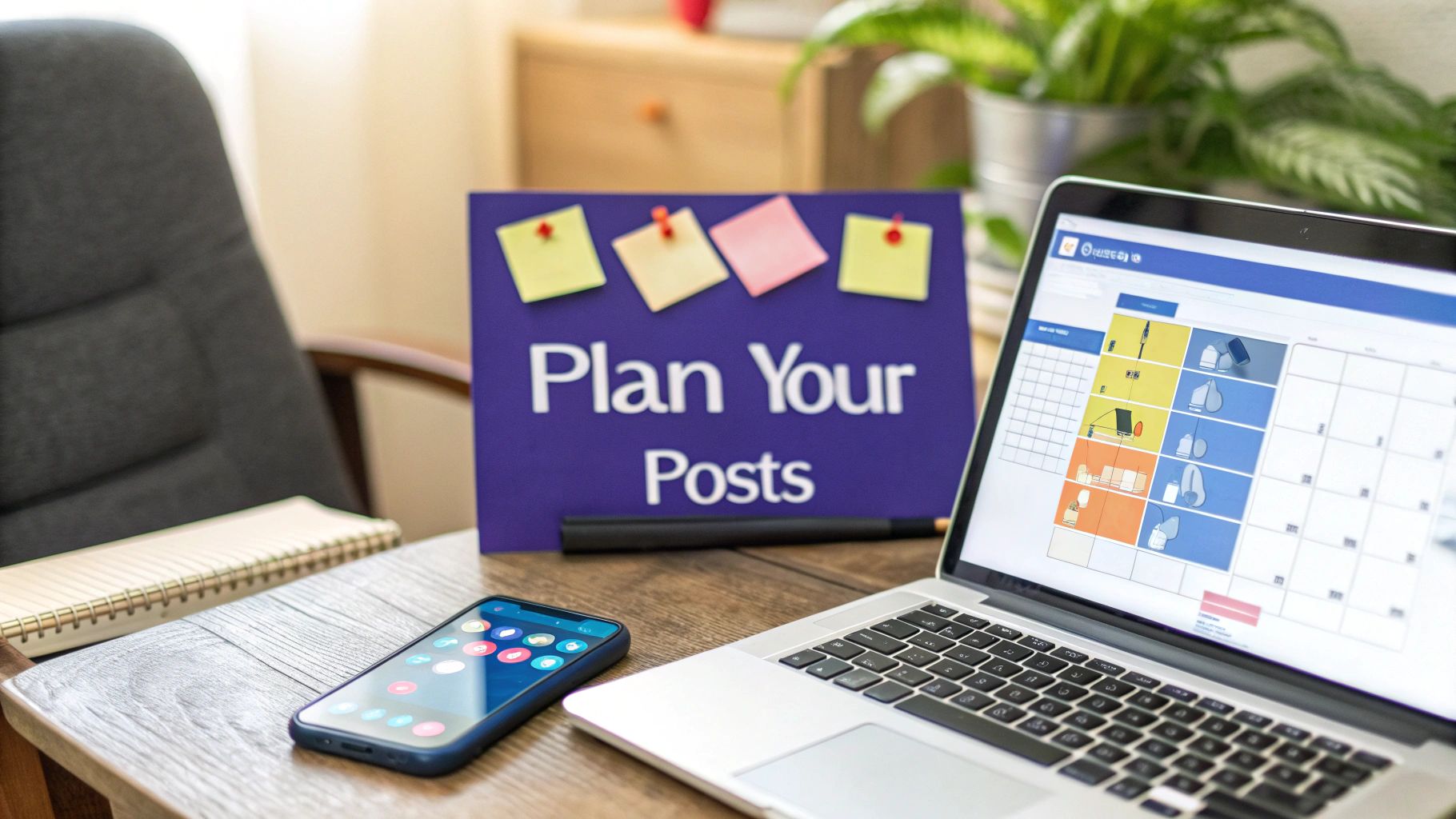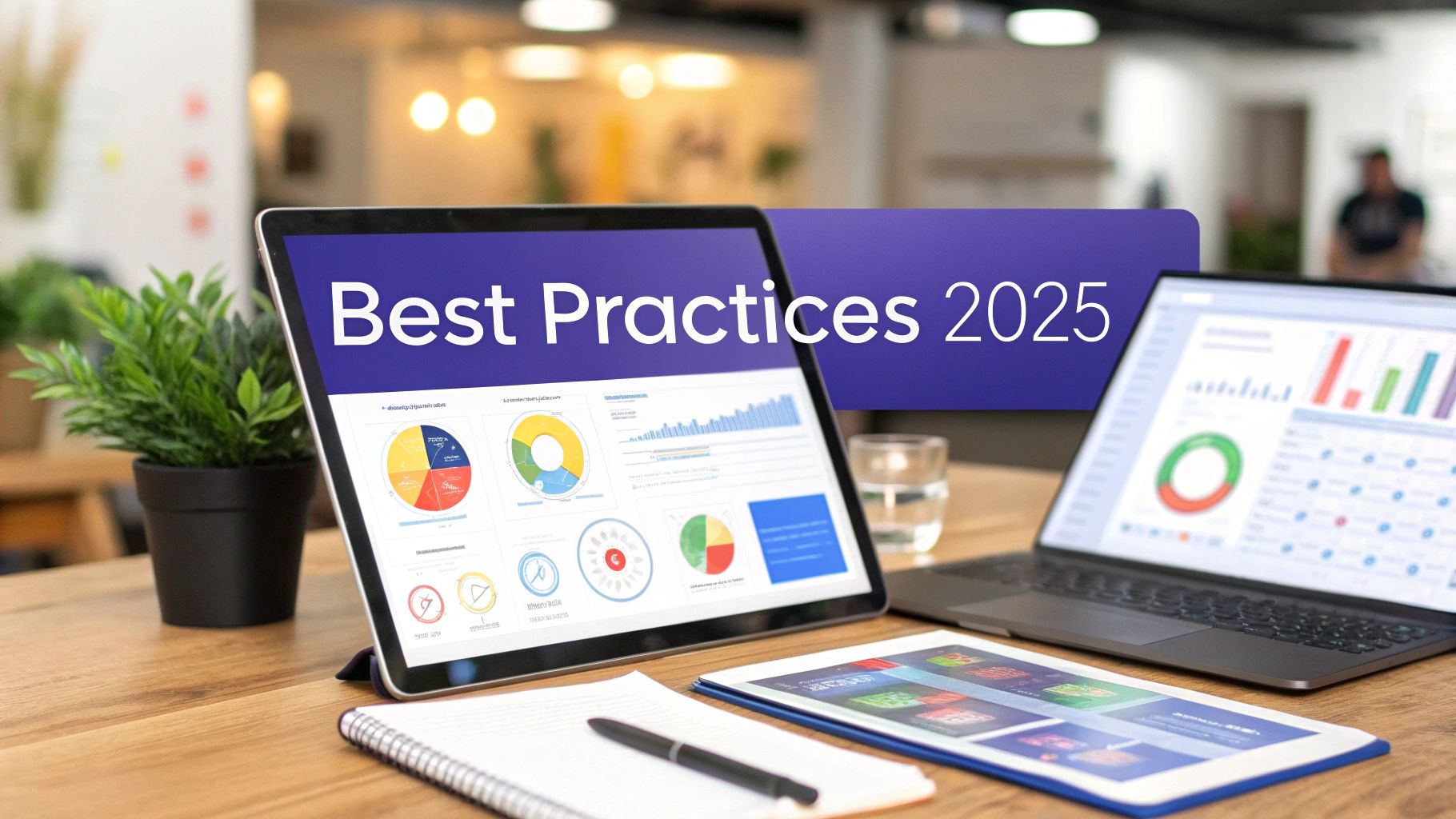What Makes a Social Media Calendar Template Actually Work
Let's be real, a social media calendar template can be a lifesaver or a total headache. The difference? It boils down to whether it's built for real-world use. It’s got to be more than just a pretty grid; it needs to be the engine of your content strategy. I've chatted with tons of social media managers, and the ones who sing their template's praises all agree: practicality trumps everything.
One crucial element is intuitive design. If your team is spending more time figuring out the template than actually using it, you've got a problem. Think visual: color-coding for different content categories (blog posts, videos, etc.), clear sections for each platform (Instagram, Facebook, LinkedIn), and a layout that's easy to scan. This makes managing your content a breeze, especially if you're using a social media scheduling tool like PostSyncer for automation.
Another essential factor is scalability. Your template needs to grow with you. A simple spreadsheet might work when you're just starting out, but as your team and social platforms expand, you'll need something more powerful. Think about features like customizable fields, integrations with other tools, and the ability to juggle multiple accounts smoothly. For example, Sprout Social offers a downloadable social media calendar template for 2025 that helps teams organize their content and stay consistent across platforms. You can find it here. This type of template reflects the growing importance of strategic planning in social media.
Finally, don't overlook the importance of collaboration. A template that lives in a silo is missing a huge opportunity. Effective templates make sharing, commenting, and getting approvals easy. Check out these influencer marketing best practices for some additional insights on collaboration. Features like real-time updates, version control, and clear role assignments are game-changers. This keeps everyone in sync and eliminates those last-minute scrambles. A well-designed template becomes the central hub for your content strategy, boosting teamwork and efficiency.
Finding Your Perfect Template Format Match
Choosing the right social media calendar template is a bit like Goldilocks trying out porridge – you want one that's just right. What works perfectly for one person or team might be a total disaster for another. Let's dive into the real-world advantages and disadvantages of different formats, from simple spreadsheets to powerful software, based on actual user experiences and team feedback.
Weighing Your Options: Spreadsheets vs. Software
For smaller teams with straightforward needs, spreadsheets like Google Sheets and Microsoft Excel are often the go-to. They're quick to set up, easy to customize, and generally free. They're great for getting started and keeping things organized when you're dealing with a smaller volume of content.
However, as your team or content needs grow, spreadsheets can become unwieldy. Imagine trying to manage feedback and revisions from a large team within a single spreadsheet – it quickly becomes a confusing mess of comments and emails.
On the other hand, dedicated social media management platforms like Hootsuite or PostSyncer offer robust features. Think direct scheduling, analytics integration, and streamlined team collaboration. While these platforms offer powerful functionality, they come with a price tag (both literally and in terms of the time investment to learn the software). For solo creators or small businesses with tight budgets, these platforms might be more than you need.
Matching Your Template to Your Team
The sheer variety of free content calendar templates available highlights just how diverse the needs of businesses and creators are. Lark, for instance, offers numerous free templates for 2025 in various formats – Excel, Google Sheets, Docs, Word, and Canva. These templates allow for customization based on specific goals and platforms. Learn more about content calendar templates here. The right template depends on factors like team size, tech skills, and how you collaborate.
To help you decide which format is best for you, let's compare a few popular options:
Before we go further, here's a quick look at some data highlighting the benefits of using a social media calendar:

This infographic shows how using a calendar can save you time and boost engagement. While the time saved each week might seem modest, the ability to schedule posts in advance has a significant impact on engagement. That increased engagement, often seen as a percentage lift, shows the value of planning and consistently posting with a structured calendar.
Now, let's get back to choosing the right template...
Below is a helpful table comparing different social media calendar template formats:
| Format | Best For | Collaboration Features | Customization Level | Cost |
|---|---|---|---|---|
| Excel | Individuals, small teams, basic needs | Limited | High | Free |
| Google Sheets | Small to medium teams, real-time collab | Real-time co-editing | High | Free |
| Canva | Visually-driven content, single users | Limited | Medium | Free/Paid |
| Specialized Tools (e.g., Hootsuite) | Larger teams, advanced features, automation | Built-in features | Medium | Paid (various) |
This table summarizes the strengths and weaknesses of each format, making it easier to see which one aligns best with your specific needs. Specialized tools offer robust features but come at a cost, while free options like Excel and Google Sheets provide flexibility but might lack advanced functionalities.
Avoiding Template Mismatches
Before settling on a template, think about potential pitfalls. If your team isn't tech-savvy, a complex software solution might not be the best choice. On the flip side, if you're managing multiple campaigns across various platforms, a simple spreadsheet won't cut it. Honestly, evaluating template features against your actual needs is the most important thing. This ensures you find the sweet spot between functionality and ease of use. The perfect social media calendar template helps you work smarter, not harder.
Creating Your Custom Template From the Ground Up
Ready to build a social media calendar template that truly works for your specific content strategy? This walkthrough starts with the basics: mapping your content and figuring out a realistic posting schedule. We'll then dive into customizing columns for your platforms, adding visuals for easier navigation, and creating a tracking system that provides valuable insights without being overly complicated.
Mapping Your Content and Posting Frequency
Before opening a spreadsheet or using scheduling software, consider your content pillars. These are the core topics you consistently address. For example, a sustainable fashion brand might have pillars like ethical production, style guides, and behind-the-scenes looks at their process. Once you've identified your pillars, determine a realistic posting frequency for each platform. Don't try to do too much at once! It's better to start small and build momentum as you find your rhythm.
Structuring Your Social Media Calendar Template Columns
Now, let's talk about the core of your template: the columns. These should provide a clear overview of what's going live, where, and when. Essential columns include:
- Date: Essential for keeping everything organized.
- Time: Scheduling posts for optimal visibility is key.
- Platform: Specify which network each post is for (Instagram, Facebook, Twitter, etc.).
- Content Type: (Image, video, text, etc.) This helps visualize your content mix.
- Topic/Theme: Connect posts back to your content pillars.
- Content: A brief summary or the actual post copy.
- Call to Action (CTA): What action do you want your audience to take?
- Link: If applicable, include the URL you're promoting.
Visuals and Tracking: Enhancing Your Template
Let's make your social media calendar template more user-friendly and insightful. Color-coding content categories or platforms allows for quick visual identification of what's planned. For example: green for blog posts, blue for videos, orange for user-generated content. Consider adding a column for visual assets, linking directly to images or videos. This streamlines collaboration, especially if you're working with a design team.
For tracking, start with simple metrics. A "Status" column (Scheduled, Published, etc.) keeps everyone informed. You can later add columns for engagement metrics (likes, shares, comments) and website traffic to understand what resonates with your audience. A simple Google Sheet can be incredibly effective for creating your initial template.

This screenshot shows a basic social media calendar template in Google Sheets. The clear column structure organizes content by date, platform, type, and topic, providing a solid foundation for tracking performance. Using a platform like Google Sheets makes customization and collaboration easy, which is perfect for individuals and small teams. Quick edits and easy sharing are vital for collaborative content planning.
Don’t be afraid to experiment! A custom template is yours to adapt. Start simple, iterate, and create a social media command center that makes planning and execution feel effortless.
Setting Up Seamless Team Collaboration
Your social media calendar template is a powerful tool, but it becomes even more so when your entire team can easily contribute. This means setting up your template with collaboration in mind, defining clear roles, and creating an approval process that actually works. Let's explore some practical ways to do this.
Defining Roles and Responsibilities
First things first: clearly define each person's role on the team. Who's writing the content? Who's scheduling the posts? Who's in charge of giving the final thumbs-up? Having clear roles eliminates confusion and makes sure everyone is accountable for their part.
For example, you might have one person as the "Content Creator," another as the "Scheduler," and a third as the "Approver." This simple setup makes it easy to track progress and spot any hold-ups. Documenting these roles right in the template itself, maybe on a separate "Team Roles" tab, keeps everyone on the same page.
Streamlining Approval Workflows
Next, set up an approval system that's actually efficient. A simple "Status" column in your template could do the trick, with options like "Draft," "Pending Approval," and "Approved."
For bigger teams, integrating your social media calendar template with a project management tool like Asana might be helpful. This allows for automated notifications and creates a clear history of approvals. Imagine all your content, feedback, and approvals in one central location – it streamlines everything and increases transparency.
Leveraging Tools for Effective Collaboration
Asana's free social media calendar template is a good example of this collaborative approach, allowing teams to easily view and manage upcoming social posts. This kind of template reflects a larger trend of businesses using digital tools to streamline content management. In 2023, around 70% of marketers were already using content calendars, showing just how widespread these planning tools have become.
Consider connecting your template with tools your team already uses. This could mean linking your calendar to your social media scheduling platform, like PostSyncer's Threads Scheduler, or syncing it with your team's main communication channels. This integration turns your calendar into a central hub, not just a separate document.
Addressing Collaboration Challenges
Common collaboration problems include things like version control, inconsistent communication, and conflicting edits. Version control is especially important when multiple people are working on the same template. Cloud-based solutions like Google Sheets offer built-in version history, making it easy to revert to older versions if needed.
Also, set up clear communication channels for feedback and revisions. A dedicated Slack channel, email thread, or a commenting system within the template itself can work well.
Finally, create guidelines for making edits to the calendar. This could mean assigning specific team members as "editors" or requiring approvals for any major changes. This maintains consistency and prevents accidental deletions or unwanted changes. By addressing these common issues head-on, you can create a collaborative space where everyone feels comfortable contributing. It takes a bit of upfront work, but building a strong collaborative system is crucial for long-term success.
Filling Your Template With Strategic Content
Now comes the exciting part: transforming your blank social media calendar template into a vibrant content plan that sparks conversations and boosts engagement. Forget haphazard posting! We're diving into strategic content ideation that truly resonates with your audience and drives your business objectives. Once your template is ready, it's time to populate it with compelling content ideas. Resources like this comprehensive guide on creating effective content calendars for social media can be incredibly helpful.
Balancing Content and Planning for Key Dates
Consider the diverse range of content you can share: educational articles, entertaining videos, behind-the-scenes sneak peeks, promotional offers, and thought-provoking questions. Finding the right mix is essential. The 80/20 rule, for example, suggests dedicating 80% of your content to providing value and engaging your audience, with the remaining 20% focused on direct promotion.
Don't forget to mark important dates on your calendar. These could include holidays, industry events, product launches, or even company milestones. Planning your content around these key dates ensures relevance and timeliness.
Aligning Content Themes With Business Objectives
Your content should be more than just interesting; it needs to align with your overall marketing strategy. For instance, if you're gearing up for a new product launch, the content leading up to it should build anticipation and highlight key features. This focused approach ensures your social media activities directly contribute to your business goals. Think about a series of posts showcasing a product's versatility in the weeks leading up to its release – that's how you generate excitement!
Creating Engaging Content Series and Maintaining Consistency
Content series are a fantastic way to cultivate a loyal audience. Think of it like your favorite show on Netflix - each episode (or post) builds on the last, creating a compelling narrative. This could be a weekly tip series, a behind-the-scenes look at your company culture, or even a multi-part tutorial. This consistent, themed approach builds anticipation and fosters engagement.
Maintaining a consistent brand voice and visual style across all your platforms is paramount. However, remember to tailor your content to each platform's unique format and audience expectations. What works on Instagram might not resonate on LinkedIn. Think visually compelling content for Instagram, professional and insightful content for LinkedIn, and conversational snippets for Twitter. This nuanced approach maximizes your reach and impact.
Variety and Focus: The Dynamic Duo of Content Planning
Keeping your content fresh and engaging is essential, but it’s easy to lose focus in the pursuit of variety. A helpful technique is to create a content bank – a collection of pre-written posts, images, and videos you can draw on when inspiration is low. This prevents last-minute scrambles and ensures a consistent posting schedule. Think of it as your go-to resource for avoiding a blank calendar.
To help you plan strategically, consider using a framework like the one below:
Monthly Content Planning Framework A strategic breakdown showing optimal content mix ratios, posting frequencies, and content types for different business goals and audience sizes.
| Content Type | Recommended Frequency | Best Engagement Times | Platform Priority | Success Metrics |
|---|---|---|---|---|
| Educational Posts (Blog links, infographics, tips) | 2-3 times per week | Mid-week mornings | LinkedIn, Facebook | Website clicks, shares, comments |
| Engaging Questions (Polls, Q&As) | 1-2 times per week | Weekdays, afternoons | Instagram, Twitter | Likes, comments, poll participation |
| Behind-the-Scenes Content (Photos, videos) | 1-2 times per week | Weekends | Instagram, Facebook | Likes, comments, shares |
| Promotional Posts (Product announcements, offers) | 1-2 times per week | Varies, test and track | All platforms | Website clicks, conversions |
| User-Generated Content (Shares, reposts) | As available | Varies | All platforms | Reach, engagement, brand mentions |
This table provides a basic framework; adjust the frequencies and times to suit your specific audience and business objectives. Analyzing your social media analytics will help you refine this plan further.
Having a content bank and a monthly framework like this turns your social media calendar template into a powerful tool, not just for scheduling, but for strategic content planning that truly resonates with your audience.

Tracking Performance and Optimizing Results
Your social media calendar template isn't just about staying organized. It's about making your content strategy smarter. Forget vanity metrics; let's talk about tracking the data that actually matters for your goals. Building performance measurement right into your template lets you shift from just posting to truly understanding what resonates with your audience.
Identifying Key Performance Indicators (KPIs)
First, pinpoint the metrics that align with your objectives. Want to drive website traffic? Clicks and conversions are your KPIs. Focused on brand awareness? Reach, impressions, and shares become more important. Adding columns for these KPIs directly into your social media calendar template lets you see the direct impact of your content. Want to add time-based reminders for content creation? Consider syncing your calendar with your Google Calendar.
For example, a "Website Clicks" column next to your post details gives you a quick snapshot of which posts are driving traffic. This direct connection between content and results highlights what's working and what needs a little love. Similarly, tracking "Conversion Rate" reveals which posts are turning engagement into actual business outcomes.
Analyzing Data and Identifying Patterns
Once you're tracking the right metrics, it's time to analyze the data and look for patterns. What types of content consistently perform well? Are certain platforms better for specific goals? Do your posts perform better at certain times of day? Your social media calendar template becomes a goldmine of insights, revealing trends that inform your future content strategy.
This data-driven approach helps you optimize your content mix. For example, if videos consistently outperform images in terms of engagement, you might create more video content. Or, if your Instagram posts are generating more website traffic than Facebook, you might adjust your platform strategy. For more ideas on streamlining your social media, check out this article on top social media scheduling tools.

This screenshot from Google Analytics shows how to visualize website traffic from different social media platforms. The platform breakdown highlights which networks are most effectively driving visitors to your site. This data is crucial for optimizing your social media calendar template, allowing you to focus on the platforms that deliver the best results.
Optimizing and Refining Your Approach
Finally, use these insights to constantly refine your approach. Experiment with different content formats, posting times, and calls to action. Track the results within your template, and don't be afraid to tweak your strategy based on the data. Your social media calendar template isn't static—it's a dynamic tool for continuous improvement. Remember, your social media landscape and audience are always evolving. Your calendar, combined with thoughtful analysis, helps you adapt and thrive.
Overcoming Common Challenges and Long-Term Success
Even with the best social media calendar template, things don't always go as planned. Knowing how to handle these bumps in the road is key to keeping your content strategy strong. Let's talk about some common issues, like staying on track when things get hectic, dealing with last-minute changes, and keeping your template from becoming too complex.
Maintaining Consistency and Adapting to Change
Life happens. Vacations, unexpected projects, or even just a crazy-busy week can throw your posting schedule off. This is where a content bank can be a lifesaver. Fill it with pre-written posts and visuals, and think of it as your emergency content kit. Having this backup ready to go means you can stay consistent even when time is tight.
Also, build some flexibility into your social media calendar template from the start. Having designated slots for "flexible content" lets you jump on timely topics or spontaneous ideas without derailing your entire plan.
Last-minute changes are just part of the game. A client request, a sudden news event, or a trending topic might require you to shift your planned content. Prioritizing posts within your template can help. Try marking some as "essential" and others as "flexible." This way, when changes inevitably happen, you’ll know which posts can be moved without impacting your overall strategy.
Preventing Template Overload and Onboarding New Team Members
As your content volume grows, your social media calendar template can become overwhelming. Regularly reviewing and archiving old content is a good way to keep things manageable. You might also consider using campaign labels or separate tabs within your template for different projects or campaigns. This helps you focus on what you’re currently working on without getting lost in a sea of past posts.
Bringing new team members on board? A clear onboarding process is essential. Provide a documented guide explaining how to use the template, who's responsible for what, and your established approval workflows. This prevents confusion and ensures everyone is on the same page and using the template correctly. A short training session or a quick video tutorial can also be incredibly helpful.
Long-Term Template Maintenance and Continuous Improvement
Your social media calendar template isn't something you can just set and forget. Regularly review its effectiveness. Are there columns that are no longer useful? Are there metrics you should be tracking that you aren't? Are there new features you need? Adapting your template to your evolving needs ensures it remains a valuable tool.
Embrace a continuous improvement mindset. Ask your team for feedback on how the template could be better. Don't be afraid to experiment with new features or layouts. The goal is to create a dynamic tool that simplifies your workflow and helps you reach your social media goals.
Ready to experience the power of a truly effective social media calendar? Start your free 7-day trial of PostSyncer today and transform your social media planning. Discover how PostSyncer can streamline your social media strategy.















